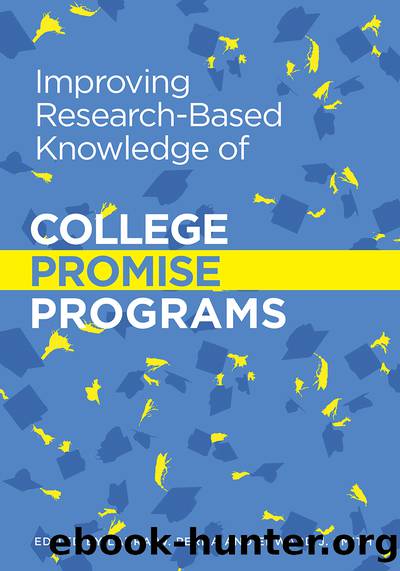Improving Research-Based Knowledge of College Promise Programs by Perna Laura W.;Smith Edward J.;

Author:Perna, Laura W.;Smith, Edward J.;
Language: eng
Format: epub
Tags: EDUCATION / Research
Publisher: American Educational Research Association
Published: 2020-03-20T00:00:00+00:00
Results
Characteristics of Community College Students
Table 2 displays a comparison of the demographic, academic, and socioeconomic characteristics of prepromise and post-promise community college students. The prepromise group includes first-time, full-time freshmen enrolled at community colleges in fall 2012, fall 2013, and fall 2014, the three fall semesters immediately preceding the implementation of the Tennessee Promise (N = 38,635). The post-promise group includes the first two cohorts of Tennessee Promise students at community colleges in fall 2015 and fall 2016 (N = 27,213); by definition, these students are first-time, full-time freshmen. There were first-time, full-time freshmen enrolled at community colleges in fall 2015 and fall 2016 who were not eligible for the Tennessee Promise, and these students are excluded from the post-promise group. Because this table does not disaggregate at the institution level, it does not account for the staggered implementation of the Tennessee Promise.
Though there were slight differences in the racial and ethnic composition of Tennessee Promise community college students compared to nontreated cohorts in previous years, the differences in first-generation status and income were more substantial. (A first-generation student was defined as a student who indicated on the FAFSA that neither parent had completed a college degree.) A smaller share of Tennessee Promise community college students were first-generation college students (42.9%) compared to previous cohorts (50.3%), and a smaller share were ever Pell-eligible (55.7%) compared to previous cohorts (71.4%). Further, Tennessee Promise community college students, on average, had higher adjusted gross incomes (AGI) and greater expected family contributions (EFC) than students in previous cohorts. In short, Tennessee Promise community college students were more advantaged, both in terms of parent education and family income, than their prepromise peers.
Table 2. Characteristics of Pre- and Post-Promise Community College Students
Note. ACT = American College Test; AGI = adjusted gross income; EFC = expected family contribution. Data are from the Tennessee Higher Education Commissionâs student information system, 2018.
Download
This site does not store any files on its server. We only index and link to content provided by other sites. Please contact the content providers to delete copyright contents if any and email us, we'll remove relevant links or contents immediately.
Best Practices for Teaching Science by Randi Stone(99)
Defending Qualitative Research by Mario Cardano(99)
When The Scientist Presents: An Audio And Video Guide To Science Talks (With Dvd-rom) : An Audio and Video Guide to Science Talks by Jean-Luc Lebrun(99)
A Question of Physics by Paul Buckley(99)
Engineering Mechanics 2: Mechanics of Materials by Dietmar Gross Werner Hauger Jörg Schröder Wolfgang Wall Javier Bonet(95)
Improving Research-Based Knowledge of College Promise Programs by Perna Laura W.;Smith Edward J.;(87)
Texts in Computer Science by Orit Hazzan(81)
Solving Everyday Problems with the Scientific Method by Thinking Like a Scientist(80)
STEM the Tide : Reforming Science, Technology, Engineering, and Math Education in America by David E. Drew(80)
Dinaric Perspectives on TIMSS 2019 : Teaching and Learning Mathematics and Science in South-Eastern Europe by Barbara Japelj Pavesić; Paulína Korsňáková; Sabine Meinck(78)
What Successful Science Teachers Do by unknow(74)
Support for Forensic Science Research: Improving the Scientific Role of the National Institute of Justice by Committee on Strengthening Forensic Science at the National Institute of Justice(73)
Researching Sustainability by Franklin Alex;Blyton Paul;(72)
The Leading World's Most Innovative Universities by Abdulrahman Obaid AI-Youbi; Adnan Hamza Mohammad Zahed; Mahmoud Nadim Nahas; Ahmad Abousree Hegazy(68)
A Passion For Discovery (237 Pages) by Peter Freund(66)
A Math-Based Writing System for Engineers. Sentence Algebra & Document Algorithms by Brad Henderson(65)
Awe in research: Igniting curiosity and connection by Sandra Skjaervoe(64)
Solving Everyday Problems with the Scientific Method (234 Pages) by Don K Mak Angela T Mak & Anthony B Mak(52)
On Ve-Degree and Ev-Degree Based Topological Properties of Silicon Carbide Si2C3-II[p, q] by Cai Zheng-Qun & Rauf Abdul & Ishtiaq Muhammad & Siddiqui Muhammad Kamran(45)
